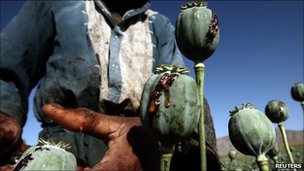
The per-hectare price of opium more than doubled
– Afghan opium production ‘rises by 61%’ compared with 2010 (BBC News, Oct. 11, 2011):
Opium production in Afghanistan rose by 61% this year compared with 2010, according to a UN report.
The increase has been attributed to rising opium prices that have driven farmers to expand cultivation of the illicit opium poppy by 7% in 2011.
Last year opium production halved largely due to a plant infection which drastically reduced yields.
Afghanistan produces 90% of the world’s opium – 5,800 tonnes this year – the main ingredient of heroin.
Analysts say that revenue from the drug has helped fund the Taliban insurgency.
Farmers who responded to the survey described economic hardship and lucrative prices as the main reasons for the increase.
Nearly 80% of the opium grown in Afghanistan is being produced in provinces in the south, including Helmand and Kandahar, which are among the most volatile in the country.
The UN says this demonstrates that there is a clear link between insecurity and opium cultivation.
Troubling trendHowever the BBC’s Sanjoy Majumder in Kabul says that growing pressure from the government and successful counter-narcotics operations have led to a slight decrease in cultivation in some areas, which is being seen as a positive trend.
The rise in production came even though the Afghan government and Nato have increased crop eradication measures by 65% and made significant seizures in recent months.
The report says that there are now 17 provinces in Afghanistan affected by poppy cultivation, up from 14 one year ago.
Three provinces that had been declared “poppy free” – enabling them to receive extra development funding – have slipped back and are now opium producers again, the report said.
Correspondents say that the rise in opium production will worry Nato commanders as they try to stabilise the country so that they can hand over security responsibilities to the government.
The report says that dry opium costs about 43% more than it did a year ago, providing farmers who grow it with an extra windfall.
The per-hectare price of opium more than doubled to $10,700 (£6852) from $4,900 (£3137), according to the report.
Jean-Luc Lemahieu, the head of UN Office on Drugs and Crime (UNODC) in Afghanistan, said that the extra revenue was helping to fund crime.
“We cannot afford to ignore the record profits for non-farmers, such as traders and insurgents, which in turn fuels corruption, criminality and instability. This is a distressing situation,” he said in a statement.
Mr Lemahieu said that if the profits of manufacturing and trafficking heroin are taken into account, opium is a significant part of the Afghan economy.
Experts say the Taliban’s involvement in the drugs trade ranges from direct involvement – such as providing farmers with seed, fertiliser and cash advances for their crop – to distribution and protection.



